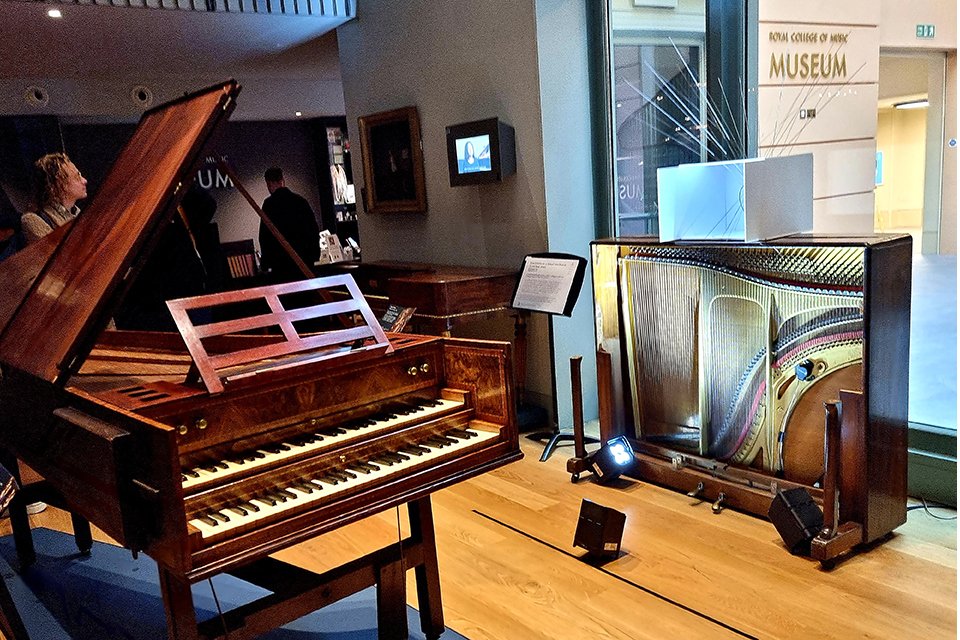Museum blog: There is always something to see, something to hear
Tuesday 2 August 2022
Since the Royal College of Music (RCM) Museum reopened in October 2021, students from the Composition Faculty have been taking inspiration from the 500 years of musical history represented in its collections.
The instruments housed in the Museum were made to be played and the spaces they inhabit were designed to be filled with sound. In recent months, students involved in Great Exhibitionists, a cutting-edge and student-led series at the RCM, have devised their own experimental, multi-media events inspired by the Museum’s collections.
In this blog post, Liam Dougherty, a first-year composer on the Master of Music in Composition programme reflects on silence, the untapped potential of unused instruments and how ‘a renewed commitment to life and decay, always’ was imagined.
My first experience of the new RCM Museum was a calm afternoon near the beginning of the academic year. I think it was the first time I had ever seen a dedicated exhibition of historical instruments. As I made my way around the keyboard instruments and cases, there was one aspect of the visit that made a lasting impression on me: the silence.
‘There is no such thing as an empty space or an empty time. There is always something to see, something to hear. In fact, try as we may to make a silence, we cannot.’ - John Cage
As I stood alone in the quiet gallery, I was captivated by the sonic potential that surrounded me: the potential of instruments designed to produce specific sounds, but which now stood as sculptural objects or artworks. I left the Museum that day feeling inspired to explore and uncover the sonic potential of these instruments in their unused state.
As a composer, I am particularly concerned with the quality of sound rather than traditional melody or harmony. I am fascinated by aspects such as tone and volume that allow us, as listeners, to experience a sound for what it is. Fortunately, my collaborator, Shirley Renwick, a multimedia artist, shared this interest in the relationship between sounds and objects that might otherwise go unnoticed. With this same vision we set out to display a historical instrument (not one from the collection) in the Museum as a sculptural form and reveal its inner sonic potential.
The result was ‘a renewed commitment to life and decay, always’ - an interactive audio-visual installation which was performed in the Museum as part of the RCM’s Great Exhibitionist series. Visitors were confronted with a 100-year-old upright piano which had been stripped down so its soundboard and strings were visible. This element was paired with a sculpture made of piano wire.
A piano’s soundboard is remarkable. In my installation, walking past the instrument caused the strings to make a sound. To harness this potential energy, we installed transducers into the soundboard which then transformed audio signals in physical vibrations. We placed a microphone in front of the strings, which sent any sound into the transducers, which in turn shook the soundboard and caused the instrument to resonate again in a feedback loop. Thanks to some software, we then manipulated the feedback and represented it visually. A software-rendered visual of piano wires was projected into the space that responded in the same way physical strings do. The more intense the sound, the greater the excitement of the strings.
In total our installation lasted five hours during which time I created several different sonic situations for visitors to witness. Feedback could be loud and unpredictable, and it was certainly a challenge to keep things just at the edge of spiralling out of control. It was so interesting to see how different people interacted with the instrument. Some wanted to get close to its inner workings to try and provoke a response, while other were happy to observe the deep rumbles from a distance. All these reactions were welcome, as we hoped to encourage our audience to think about the objects and spaces around them in a new way. We wanted people to see the Museum’s collections not as passive, silent artefacts but as a self-contained force of sound just waiting to be revealed.
Liam Dougherty
Master of Music in Composition Year 1
Find out more about studying Composition at the Royal College of Music here.








